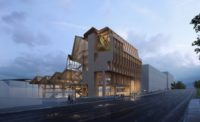Northwest Arkansas Free Health Center
Cure for the common clinic: A free regional health center embodies wellness in its refined simplicity.












Architects & Firms
Fayetteville, Arkansas
Marlon Blackwell has a gift for seeing potential in the commonplace. During a tour of his latest pro bono project, Fayetteville's new Northwest Arkansas Free Medical Center, the architect veered off to a window and pointed to the eccentric form of a derelict incinerator building in an adjacent lot. “Look at that! If you leave the roof and rework the other side . . .” His voice picked up pace as he mentally renovated the structure. Blackwell's brief musing illustrates precisely the approach that his firm took in designing the clinic: bring new life and clarity to an existing but mundane building. “Our approach to adaptive reuse or renovation is to look at its DNA and extend that DNA into how the building evolves,” says the architect.
In the new building, the client sought to double the number of medical exam rooms and the number of chairs in its dental clinic, in addition to having a pharmacy, community meeting room, and administrative areas. Marlon Blackwell Architect tries to provide one pro bono schematic design every year. The timing was just right when the medical center approached the firm about the project. “Architecture can provide a sense of dignity to an experience,” notes Blackwell. With this in mind, the architects chose to focus on the public spaces. One of their first challenges was to transform the building's dark interior so as to convey a sense of vibrancy and vitality. “I kept imagining a tunnel of light down the central axis of the building, so that as soon as you enter you feel a sense of wellness,” says Meryati Johari Blackwell, a principal at Marlon Blackwell Architect (and Marlon's wife).
The scheme emphasizes the generous central corridor that bisects the symmetrical H-shape floor plan. On both sides of this axis, the architects placed two red oak–lined waiting rooms or “pods” that resemble open wooden boxes turned on their sides. Clerestory windows, once obscured by HVAC ducts, let in generous daylight. The focal point of this passageway is a frameless glass meeting room at the south end of the building.
This bifurcated plan neatly accommodates the two primary program elements, with medical examination rooms on one side of the central corridor and a dental clinic on the other. The wall and ceiling surfaces are white except in the wood waiting areas, which creates a balance between the intimate pods and the bright, tall circulation space.
The architects made few alterations to the existing facade, though they inserted windows along the east and west sides to bring daylight into the treatment areas. The only other addition to the exterior is a cantilevered canopy and glass vestibule at the entrance.
As with any project for a nonprofit dependent on grants and donors, keeping costs low was key. The team hunted down inexpensive finishes that fit their desired material palette. Many of them, such as plastic laminates, came from manufacturers' overruns. For the waiting areas, the contractor located a deal on locally sourced red oak that was prefinished, which saved the labor costs of sanding and coating the material on walls and ceilings.
“The clinic is about half the cost per square foot of other medical facilities we've done in the area,” says Ryan Bennet, vice president of SSI, the contractor for the project. The pro bono work of the architects and SSI helped keep costs at around $70 per square foot.
The new health-care center is a study in making use of simple geometries and modest materials to create beautiful, functional architecture. “Formal logic isn't complete without material logic,” Blackwell notes. And the facility seems to have a positive effect on its users: the clients treat the place with more respect than the dilapidated former clinic, says executive director Monika Fischer-Massie.
Having a strong set of design principles, Blackwell adds, allows the architect to shape rather than be controlled by circumstance. These principles, as applied at the Northwest Arkansas Free Medical Center, serve as evidence that much can be made from humble beginnings.
People
Client:
Owner:
Architect:
Personnel in architect's firm who should receive special credit:
Justin Hershberger, Associate AIA
Interior designer:
Engineers:
HP Engineering (MEP)
General contractor:
Photographer(s): Size: 9,700 square feet Project cost: $630,000 square feet Completion date: January 2013 |
Products
Structural system
Exterior cladding Storefront Windows and doors: Tubelite
Roofing
Windows Custom steel window boxes: Fig Tree Inc. Structural Steel Fabrication and Manufacturing
Glazing
Doors Wood doors: Marshfield Hollow metal door frames: Ceco Door, Assa Abloy Aluminum door frames: Tubelite
Hardware Closers: LCN Overhead stop: Glynn-Jo Kick plate, cylinder, wall stop, locks and silencer: Hager Key Cabinet: LundEqui Pulls: Rockwood Cabinet Hardware: Blum
Interior finishes Cabinetwork and custom woodwork: Custom designed by Marlon Blackwell Architect, fabrication by Kitchen Distributors Inc. Fire Extinguisher Cabinets: JL Industries Paints and stains: Sherwin Williams, Acoustic Ceiling tile: Dune by Armstrong, All Millwork: custom design by Marlon Blackwell Architect, fabrication by: Kitchen Distributor Inc. Plastic laminate: Nevamar Resilient flooring: Centiva Vinyl tiles Bathroom Tiles: American Olean, Infusion Carpet: Tandus Flooring (Aftermath ER 3), Entry Mat: Mats Inc Ultra Track Wood strip Flooring: Arkansas red oak.
Furnishings
Lighting
Plumbing |










